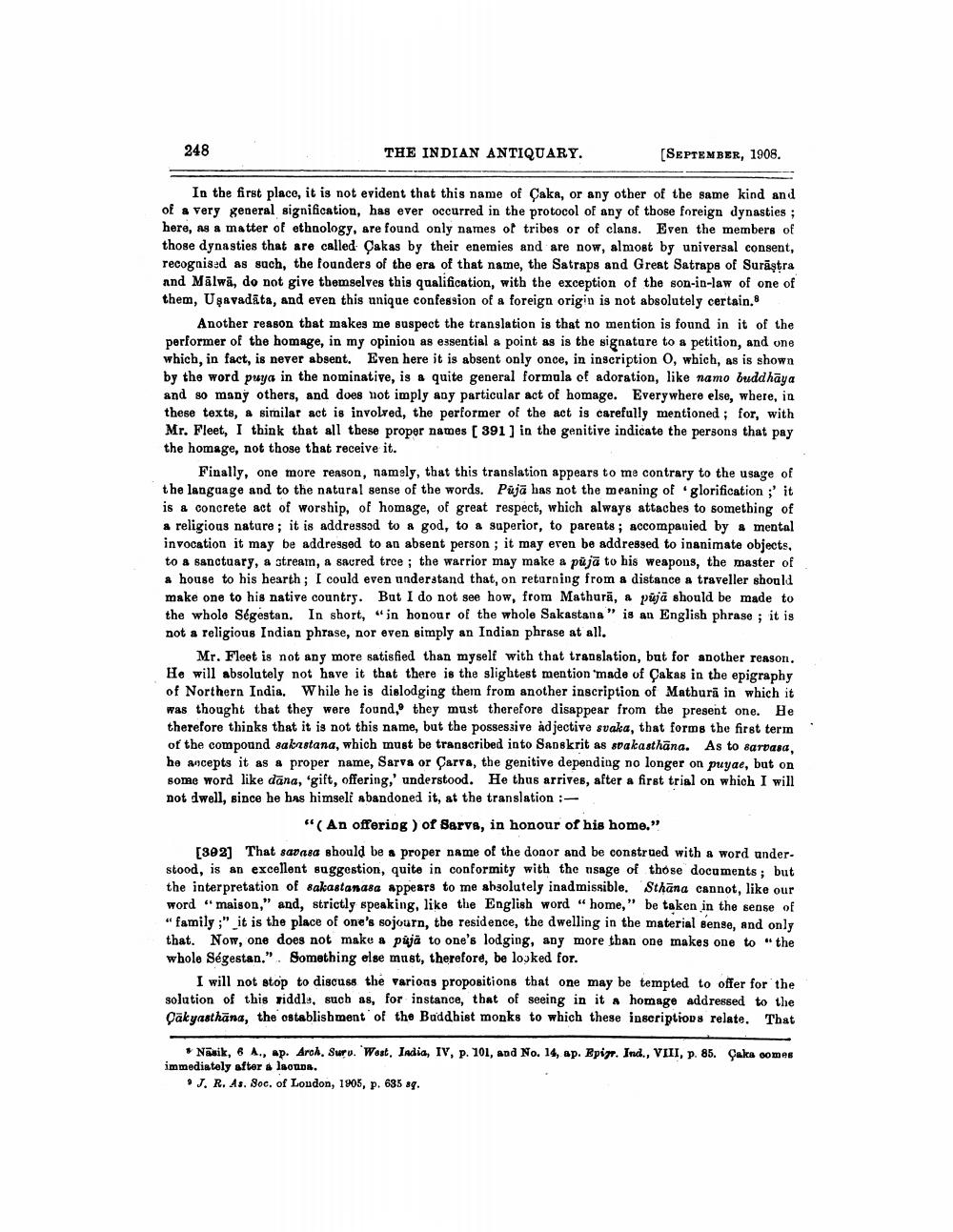________________
248
THE INDIAN ANTIQUARY.
[SEPTEMBER, 1908.
In the first place, it is not evident that this name of Çaka, or any other of the same kind and of a very general signification, has ever occurred in the protocol of any of those foreign dynasties; here, as a matter of ethnology, are found only names of tribes or of clans. Even the members of those dynasties that are called Cakas by their enemies and are now, almost by universal consent, recognised as such, the founders of the era of that name, the Satraps and Great Satraps of Surāştra and Mālwā, do not give themselves this qualification, with the exception of the son-in-law of one of them, Uşavadāta, and even this unique confession of a foreign origin is not absolutely certain.
Another reason that makes me suspect the translation is that no mention is found in it of the performer of the homage, in my opinion as essential a point as is the signature to a petition, and one which, in fact, is never absent. Even here it is absent only once, in inscription 0, which, as is shown by the word puya in the nominative, is a quite general formula of adoration, like namo buddhāya and so many others, and does not imply any particular act of homage. Everywhere else, where, in these texts, a similar act is involved, the performer of the act is carefully mentioned ; for, with Mr. Fleet, I think that all these proper names [ 391 ] in the genitive indicate the persons that pay the homage, not those that receive it.
Finally, one more reason, namely, that this translation appears to me contrary to the usage of the language and to the natural sense of the words. Pūjā has not the meaning of glorification ;' it is a concrete act of worship, of homage, of great respect, which always attaches to something of a religious nature; it is addressed to a god, to a superior, to parents ; accompanied by a mental invocation it may be addressed to an absent person ; it may even be addressed to inanimate objects, to a sanctuary, a stream, a sacred tree; the warrior may make a půjā to his weapons, the master of a house to his hearth; I could even understand that, on returning from a distance a traveller should make one to his native country. But I do not see how, from Mathurā, & pūjā should be made to the whole Ségestan. In short, “jn honour of the whole Sakastana" is an English phrase ; it is not a religious Indian phrase, nor even simply an Indian phrase at all.
Mr. Fleet is not any more satisfied than myself with that translation, but for another reason. He will absolutely not have it that there is the slightest mention made of Çakas in the epigraphy of Northern India. While he is dislodging them from another inscription of Mathurä in which it was thought that they were found, they must therefore disappear from the present one. He therefore thinks that it is not this name, but the possessive adjective svaka, that forms the first term of the compound sakustana, which must be transcribed into Sanskrit as svakasthāna. As to sardasa, he ancepts it as a proper name, Sarva or Çarva, the genitive depending no longer on puyae, but on some word like dana, 'gift, offering,' understood. He thus arrives, after a first trial on which I will not dwell, since he has himseli abandoned it, at the translation :
"(An offering ) of Sarva, in honour of his home." [302] That savasa should be a proper name of the donor and be construed with a word understood, is an excellent suggestion, quite in conformity with the usage of those documents; but the interpretation of sakastanasa appears to me absolutely inadmissible. Sthāna cannot, like our word "maison," and, strictly speaking, like the English word "home," be taken in the sense of "family;" it is the place of one's sojourn, the residence, the dwelling in the material sense, and only that. Now, one does not make a püja to one's lodging, any more than one makes one to the whole Ségestan.". Something else must, therefore, be looked for.
I will not stop to discuss the varions propositions that one may be tempted to offer for the solution of this viddls, such as, for instance, that of seeing in it homage addressed to the Cāk yasthāna, the ostablishment of the Buddhist monks to which these inscriptions relate. That
Näaik, 6 A., ap. Aroh. Suru. West, India, IV, p. 101, and No. 14, ap. Epizr. Ind., VIII, p. 85. Çaka somes immediately after a laonna.
J. R. As. Soc. of London, 1905, p. 685 sq.




